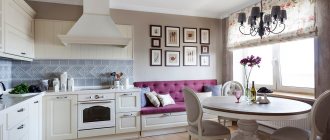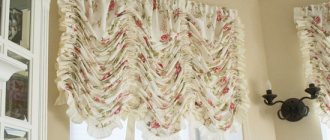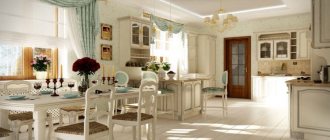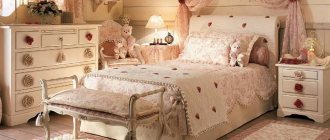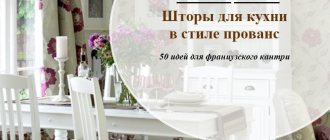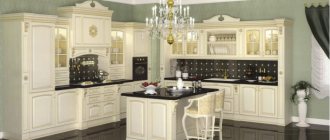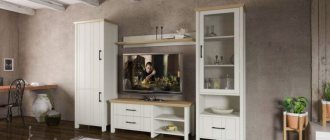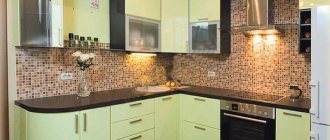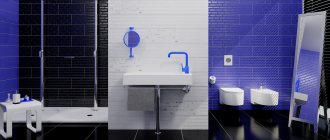Provence is a currently popular style, also called “rustic”. The atmosphere in rooms where people spend a lot of time should not be “heavy”. To make it pleasant to be in the room, as well as to maintain the style as much as possible, you need to carefully think through and select all the details - wallpaper, flooring, furniture, an apron for a kitchen in the Provence style.
Kitchens in this style seem very light and sunny. Being in them, you feel a feeling of lightness and comfort.
Apron
Provence tiles for the kitchen on the apron, usually in color and design, differ from the design of the rest of the walls. It will be glossy or matte, large or small, variegated or plain, square or rectangular. Glass tiles are also often used to decorate backsplashes. In some cases, even mosaic is used - the interior with such an apron looks expensive and original.
Mosaic tiles are successfully used for laying a backsplash in a Provence style kitchen.
Tile
We recommend choosing ceramic tiles for a Provence style backsplash.
Advantages of tiles:
- It looks good and can be made in any color.
- The variety of tile shapes and ways of laying them allows you to create a unique apron.
- Easy to clean.
- You can find cheap options.
Cons of tiles:
- As a rule, it has a shine, which is not appropriate in all interiors.
- You need to take care of what fills the joints between the tiles: it should be a good material, it is advisable that dirt can be easily washed off from it.
Interesting article: Kitchen apron made of Spanish tiles: mosaic, ceramics and glass
Why do we recommend only tiles? Metal is not suitable for Provence , since the metal surface is too far from the provincial rustic style. Stone, granite or marble, will shine too much, especially since the stone surface also does not correspond to the style of the French village.
Wood is the best material for Provence , but not for an apron: boards painted white and laid vertically would look great, but under varnish they will not look so good, and they cannot be left without varnish. Moreover, even a varnished wooden surface is sensitive to aggressive cleaning, and it should not be placed near the stove.
Another option that does not contradict the features of a Provence style kitchen is a mirror surface. Mirrors meet the requirements of minimalism (which Provence has a penchant for), visually enlarging the space. However, if you work a lot in the kitchen, you should think about whether you will get a headache from the reflection constantly flashing in front of you and the “duplication” of appliances and ingredients.
Advice! If something in your opinion looks really good, but does not correspond to the “canons” of Provence, do not be afraid to use it. Still, your goal is not to copy French provincial cuisine, but to create an interior that will please the eye and bring comfort to the home.]
Color scheme for a kitchen in Provence style
In Provence, almost all colors of the rainbow are acceptable, although dark shades are present here only as accent shades. The walls are usually made plain, the curtains are colorful, and the rugs are striped. The ceiling is always lighter than the walls, and the floor is the darkest. The preferred colors are any pastel, although modern designers often use relatively bright contrasts, without going beyond the style.
White
A snow-white room is the most popular, beautiful, space-expanding option. A coating in this color is easily soiled, especially if it has a complex texture, so you will have to wash it and clean it of dirt often and especially carefully. White includes a number of shades:
- cream;
- antique white;
- gridperleft;
- biscuit;
- spring bud;
- pearl;
- creamy;
- magnolia;
- Ivory.
Blue
A blue color scheme is usually used to decorate a set placed on a creamy white or light gray background. Matte, pale, sun-bleached tones are preferred, but brighter ones are acceptable as individual accents.
Popular shades of blue:
- black and blue;
- indigo;
- dark azure;
- sapphire;
- purple blue;
- ultramarine;
- signal blue;
- cobalt.
Green
Greenery in a “French” interior has a warm but muted hue. Individual accents are made brighter, although more often they are dispensed with. Climbing plants are placed here on window sills, shelves, and in wall pots. Green Provence tiles are laid on the floor, partially or completely painted in the following tones:
- emerald;
- tea green;
- bluish green;
- jade;
- lime;
- herbal;
- pine.
Blue
Provence in blue tones is associated with the sea, the surface of water, so on the walls it is permissible to place a couple of paintings in wooden frames depicting water in any of its forms. This tone is used to decorate the set, less often – the general background. The blue room is decorated in shades such as:
- sky blue;
- azure;
- pastel turquoise;
- denim;
- aquamarine;
- cornflower;
- Niagara;
- gray
Pistachio
The pistachio room is often made monochromatic. When the apron is decorated in this tone, the remaining walls are covered with washable floral wallpaper. This shade is combined with all wood colors, blue, pink, gray, white, red.
The pistachio set harmonizes with tulle of the same color; the background in this case is chosen “warm” - light yellow, saffron, pale orange. Pistachio-colored ceramic tiles are available in the collections of many manufacturers.
The pistachio set in the Provence style kitchen harmonizes perfectly with curtains of the same tone.
Beige
Furnishings in beige color do not look boring. For the “French village” this is one of the most suitable shades, combining perfectly with violet, lavender, and light green. The easiest way to use this color is to decorate the background, making furniture and curtains brighter. In light, spacious rooms, beige shades, of which there are several hundred, are made as dark and cold as possible. For cramped, dimly lit spaces, warm, light ones are selected.
Warm beige shades are ideal for decorating kitchens in the Provence style.
Many types of wood are also beige in color - floors, doors, window frames, and baseboards are made from this wood.
Olive
Olive color in Provence is acceptable in several variants. Spacious, well-lit rooms are decorated with olive-black; cramped rooms with virtually no natural light are decorated with olive-yellow or olive-green. Facades and wallpaper are decorated in a light tone, while floors, countertops, and aprons are decorated in a darker tone.
An olive-colored tile apron for a Provence-style kitchen gives the interior freshness and a unique zest.
The most suitable decor is living green plants in flowerpots and tubs. Suitable combinations are with coffee, terracotta, dusty light green.
The main advantage of this color scheme is that dirt is hardly visible on it.
Color palette
The favorites of Provençal interiors are pastel shades in a wide palette. Colors should not be too bright and flashy - naturalness is encouraged in everything, even in shades. The most successful color options would be:
- white is a classic color that goes perfectly with any other tone. But you shouldn’t make the kitchen completely white, otherwise you will create the effect of a “hospital” interior;
- olive – makes the kitchen cozy, harmonizes well with furniture in dark colors. Dark olive color is suitable for large rooms, light olive color is suitable for small rooms;
- pistachio - refreshes kitchen decoration, makes the kitchen summer and airy, ideally combined with light and dark wood;
- sand and brown - these colors look familiar because they are appropriate in almost all styles, not only Provençal;
- blue - refreshes the interior, introduces a touch of coolness, as it is associated with the sea. Blue and white colors are an ideal tandem;
- any variants of blue “work” in the same way as blue, but have better combinatorial properties. They harmonize not only with white, but also with green, brown, and blue.
Finishing floors, walls, ceilings
The interior design of the “French village” looks old and shabby. The ceilings and walls often feature rough wooden elements, as if they were made at a time when only an ax was available as a tool. Floors are most often wood, painted red-brown, but tile materials are also acceptable.
Floors for Provence kitchens are most often made to look like wood and have dark shades.
When choosing tiles, it is important to consider that wall material cannot be used as a floor covering. Floor tiles are stronger, thicker, wear-resistant, and are often coated with an anti-slip layer to make it more difficult to slip or get injured. Wall tiles are relatively fragile, thin, and most often smooth.
Kinds
In most cases, when choosing ceramics for a backsplash for a Provence style kitchen, they pay attention not to its cost, but to its appearance. This is explained by the fact that the tiled covering should be the highlight and main decoration of the room. Taking this point into account, there are several types of tiles.
Terracotta with patterns
This material is considered new for 2022 and has a whole kaleidoscope of Mediterranean patterns. It is widely used not only to create an apron, but also as a floor covering. The released collection includes several different shades of terracotta and about 10 different patterns.
Advantages of aprons for a kitchen in the Provence style: photos, as well as tiles in the style of a warm French village"
White and blue colors
This colorway perfectly reflects 17th century European fashion. At that time, all homes, from Portugal to Holland, were decorated with white and blue patterns (birds were especially popular). French aristocrats considered it their duty to decorate their summer houses with white and blue tiles, and the best ceramic products of this format went only to the French and English kings.
And now the fashion for white and blue ceramic products has not completely passed; they are actively used to decorate bathrooms or kitchen aprons. And since Provence has different shades of the sea, white and blue ceramics will be the ideal solution.
Under the brick
Most often, such ceramics are presented in the form of a “hog”. It completely imitates the geometry of natural brick, but the greatest advantage is considered to be ease of cleaning.
The surface can be of the following types:
- smooth (almost glossy);
- rough.
The note! The strongest decorative effect is observed in red unglazed ceramic products.
For a Provence style apron, ceramics with a rough surface and any pastel colors are also perfect. To give the interior completeness, professionals recommend laying such ceramic products with wide seams.
Hexagon
Such an unusual material will fit perfectly into an interior that combines a combination of several styles, namely:
- Provence;
- Eclecticism;
- Modern.
Such ceramics can combine motifs of Spanish Art Nouveau by analogy with the style of the famous architect Gaudi, fragments of marble, fabric inserts, geometric patterns, fragments of flowers (characteristic of Provence) and denim fragments.
A rather interesting option are classic hexagonal ceramic products containing Mediterranean patterns of Provence and patchwork style elements.
Interesting article: Choosing a chandelier for a kitchen in Provence style: ideas and modern trends
Information! This ceramics is widely used by newfangled designers who love original solutions.
The material has a hexagon format, but most of the designs are made using chipped ceramics, so it is quite difficult to determine the exact dimensions.
Arabesque
When choosing this option for a ceramic product, you need to make sure that the design is suitable in style for Provence, most often it is a variety of floral patterns, geometric shapes, leaves.
A significant advantage of arabesque ceramic products for use in a kitchen apron is that they are resistant to detergents, chemicals, grease and wine stains.
Patchwork style
For the first time, people started talking about patchwork ceramic products in the United States. This technique goes well with a kitchen decorated in French style; it can also be used when arranging a kitchen in the style of Kitsch, Country or Eclectic. On the territory of European countries, they learned about this technique only at the end of the 19th century, and then thanks to Arabic majolica.
When using this ceramic product for a kitchen apron in the Provence style, it is recommended to pay attention to the smooth, almost glossy surface, which provides the impression of a seamless ceramic fabric. In these situations, a thin grout joint is used.
An original option would be patchwork tiles that imitate antiquity.
Preferred shades:
- gray;
- blue;
- pearl.
Drawings must be graphic, floral or fantasy.
Curtains
“French” kitchen decor is unthinkable without beautiful curtains. Traditionally, they are decorated with “natural” ornaments - stylized cockerels, sunflowers, daisies, lavender, etc. Natural textiles are preferable - linen, cotton. Chintz curtains with small flowers, starting from the middle of the window, are practically the “calling card” of the style. Sometimes roller blinds made of straw and bamboo are used.
Traditionally, curtains for kitchens in the Provence style are decorated with all kinds of ruffles and draperies.
Curtains here also include draperies located inside wall cabinets and replacing doors in them. The lower tables are sometimes decorated with valances that match the color of the window curtains. Niches and bay windows in spacious rooms can also be separated with curtains. Lace, all kinds of frills, embroidery make the interior truly cozy.
One of the popular colors is checkered; these curtains have three shades of the same color. The pattern is duplicated on tablecloths, blankets, chair covers, etc.
Application area
Having stood the test of time, ceramic tiles remain a popular facing material. Sometimes it is chosen for partial decoration of the living room, but this technique is most often found in studio-type rooms and helps to beautifully zone the space. In other cases, the fireplace area is lined with ceramics, but its usual scope is the kitchen and bathroom.
Cladding of the fireplace area Source gipermarket-plitki.ru
Kitchen
To make the interior stylish and cozy in the French way, the kitchen palette must contain warm shades: beige, milky, light caramel. White color is used in doses; it can be found more often in ceiling decoration and furniture than in ceramics.
The palette is complemented by shades of wood, as well as olive, blue, pastel yellow and green. Richer tones are present in small quantities: lavender, blue, terracotta.
Zoning with tiles Source pinimg.com
The floor is the most stable part of the interior, so Provence style floor tiles are chosen according to the following criteria:
- The best choice is ceramics stylized as natural stone (slate or marble) or solid wood. It is ideal if the flooring matches the furniture.
- To give a special French chic to the interior, ceramics are laid diagonally. In this case, the tiles can be one- or two-color, or have several shades of the same tone.
Diagonal laying of tiles on the floor Source keramekb.ru
- The kitchen is considered a walk-through place, so a wear-resistant matte finish is chosen for flooring. For the same reason, they prefer neutral, beige and sand tones that hide dirt well.
There are two options for decorating kitchen walls. In the first case, smooth tiles are chosen, and their decor can be made only in pastel colors, or combine pastel and bright shades. In the second case, they choose ceramics that imitate brick. Its color is limited to light shades: beige, milky, rarely white or light gray.
Relief tiles on the kitchen backsplash Source ceramiques-du-beaujolais.com
The impression of the design can be enhanced by tiling the tabletop, for which you choose a stone-like material. Another commonly used technique is tiling the backsplash. A ceramic kitchen apron is a functional and beautiful detail, which is often used as a decorative accent.
For the apron, choose small format tiles (10 or 12 cm), mosaic ceramics look trendy, as well as options with images in a provincial theme (possibly photo tiles). This could be a rural landscape, dishes, an olive branch, fruit, a lavender field.
Beige trim with red pattern Source pinimg.com
Kitchen furniture
Furniture is the main element of the kitchen interior, along with household appliances. The furniture and furnishings of the dining area reek of antiquity - slightly worn facades, cracked paint here and there are not a drawback, but a sign of style. It’s easy to fit into the interior a good-quality, heavy chest of drawers or sideboard, wicker or rattan chairs, bookcases, and a wooden set with perforated doors.
A tall, artificially aged wardrobe with paneled fronts will fit perfectly into the overall design. Behind its doors it is easy to hide almost all modern household appliances that can disrupt the Provencal atmosphere. Forged elements are also acceptable - these are the legs of chairs and a table located in the dining area, flower stands, cabinet handles.
Open shelves and artificially aged cabinets are the hallmark of Provence style kitchens.
In a Provence kitchen, you can’t do without open shelves on which jars of spices and cereals are comfortably located. There should be no gloss on furniture items.
Distinctive features of French interior
The style took shape in the summer of France, in the historical region of the same name, famous for its cuisine, pebble beaches, vineyards and lavender fields. Its essence lies in reflecting the natural beauty of nature and leisurely rural life.
Provence belongs to the rustic styles, but, unlike country, it is more refined. It is also characterized by a preference for natural materials, natural colors and furniture with a touch of antiquity. However, the furnishings look elegant and sweet, there is no trace of the rough simplicity inherent in country and similar design trends.
Classic palette in Provence style Source artcer.ru
The color palette helps convey the lightness and ease of style using the following techniques:
- The interior is dominated by light and pastel shades. White, beige, light gray, milky, sand colors are valued. Pale shades of green, blue, purple, and pink are also acceptable.
- A special feature is the use of faded, as if faded or dusty colors.
- Part of the palette consists of more saturated colors: brown, blue, olive, asphalt gray. They are present in decoration and furniture.
Traditional blue and white tiles Source alekafelki.pl
- Bright color accents are present in small quantities and are sure to harmonize with the rest of the palette.
- Colors can be plain, or with a pattern, for which in most cases floral or floral patterns, as well as stripes, are used.
- The furniture is characterized by a palette of natural or bleached wood (from light brown to milky white). Individual items can be painted with pastel pink, blue, green, and pale yellow paint.
Blue collection with floral border Source pinimg.com
Dishes
Ceramic tiles for the kitchen on the apron and dishes in the Provence style should be combined with each other, as they are located in close proximity. The dishes here are mainly porcelain, earthenware, and clay. Glass and metal are allowed only for items that are placed on fire, and plastic should be completely abandoned. Preference is given to hand-painted piece items, the main color is usually white, the patterns are made in pumpkin, light green, pinkish-brown.
Wicker baskets, boxes and various birch bark crafts are used as suitable decorative items.
A beautiful apron for the kitchen in the style of Provence is an excellent solution for a space of any size. Collections of tile materials in the spirit of the “French village” are presented in many construction markets and in online stores. Prices depend on the manufacturer, design, and quality of the product.
Basic colors of aprons
Provence is one of the light and harmonious styles, so its color palette excludes the content of dark, overly bright or neon shades. This rule is also observed when selecting tiles for the apron.
The color scheme is dictated by the picturesque places of Provence. The style contains shades of the sea, lavender fields, and warm sun.
Considering this point, use the following colors:
- blue;
- blue;
- light pink;
- light green;
- beige;
- light purple;
- lilac;
- olive.
Combinations
When combining colors of tiles for a Provence kitchen, you need to follow the main rule : there is a primary color (in which the kitchen is decorated) and an additional one (the color of the accessories). The backsplash tile should match the complementary color.
The simplest option for correctly combining shades is to use natural color palettes. The ideal solution for a French-style kitchen would be to combine materials in colors such as light brown, ash pink, blue-gray, and powder.
Important! The material should be matte, not shiny
Having dealt with color combinations, it is recommended to pay attention to a number of advantages inherent in the material for decorating a kitchen apron:
- thanks to the variety of shapes, it becomes possible to create an original apron;
- washes quickly;
- There are models at different prices, which allows you to find material that will really be affordable.
Examples of the best solutions for kitchens in Provence style
Wall decoration
In this style, wallpaper is rarely used for wall decoration. Plaster that can be painted or whitened looks much more natural. The exception is photo wallpaper. A common subject is natural landscapes, ancient frescoes and views of rural France.
It is customary to decorate walls with natural materials. In country houses, this does not require additional effort - it is enough to process the brickwork or boards. In a city apartment, making a real brick wall is problematic. Therefore, it can be replaced with decorative imitation. An apron for a Provence kitchen is most often made from ceramic tiles.
Instagram @provans_like
Instagram @styleville.mebel
Instagram @art_osobinka
Instagram @dizain177
Lighting
Provence style implies an abundance of daylight penetrating the room. That is why you should not limit yourself to just the central chandelier. The best option would be to install lamps around the perimeter of the ceiling. The devices themselves must also maintain a unified style. You should choose an appropriate chandelier, the appearance of which will harmoniously fit into the atmosphere of the kitchen. The most suitable materials for lighting fixtures are copper, bronze, brass, and porcelain.
Kitchen set in Provencal style
In many photos you can see that the kitchen set can be quite different: from roughly put together shelves to an exquisite antique sideboard with several tables included. Most often, the furniture is white or off-white, slightly shabby against the background of light blue, pink or greenish walls. Less often, the set is painted in the colors of mint or sky. Enameled handles painted in the same tone will look harmonious with it.
Furniture for the work area? usually simple in shape. Its decorativeness lies in its exquisite simplicity. Handles often serve as additional decoration. They can be wooden - matching the color of the set, but forged fittings look more interesting. Forged products can also be used in other settings:
- handles of a chest for storing utensils, which can be used instead of a bench;
- lamps in the form of lanterns;
- legs of chairs or tables;
- flower stands.
Features of Provence
A few characteristic nuances:
- For the Provencal style, it is appropriate to have textiles, furniture upholstery, dishes and decor with floral patterns, as well as decorations in the form of airy lace and macrame.
- The interior is done in pastel and sun-bleached colors with the addition of small bright accents.
- The kitchen is furnished with simple wooden furniture with open shelves and built-in niches.
- In the design it is possible to use unpainted or bleached ceiling beams and available finishing materials in the form of wood, clay, brick or stone with a natural texture.
Tabletop in Provencal style
A similar detail of the work area, like an apron, usually requires special attention, since these are the surfaces that are most in contact with water, food, and hot objects. Therefore, the materials of the tabletop and apron must be wear-resistant and resistant to temperature changes; should not absorb odors and moisture. Therefore, their choice for a Provence-style kitchen is no different from the choice for any other design. But here it is important to follow the rules of composition, palette and nature of the setting.
Table top? This is most often the top surface of free-standing cabinets. There is absolutely no need to remodel old furniture. Of course, when a new set is made, stylized in Provence, then the tabletop will be present as a single surface. In this case, traditional desktop materials are chosen: artificial stone, sawdust boards laminated with wear-resistant coatings, or wooden solutions.
The work desk can be any color, but not bright? preference should be given to natural shades of wood or stone.
